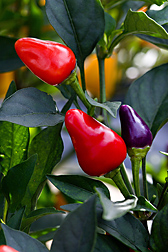This page has been archived and is being provided for reference purposes only. The page is no longer being updated, and therefore, links on the page may be invalid.
Read the magazine story to find out more. |
|
Twice as Nice: Versatile Vegetables Pack a Double Punch
By Laura McGinnisSeptember 5, 2006
Since 1991, Agricultural Research Service (ARS) scientists John Stommel and Robert Griesbach have bred peppers to please both the eye and the palate. The effort has produced culinary ornamental peppers that are attractive, tasty and nutritious, the most recent of which is the award-winning Black Pearl.
What health benefits do culinary ornamental peppers have? And what can they teach us about other plants? Griesbach and Stommel are exploring the biochemistry of the anthocyanin pigments responsible for the Black Pearl pepper’s deep-black color.
Griesbach is with the ARS Floral and Nursery Plants Research Unit, and Stommel is with the agency's Vegetable Laboratory. Both labs are part of the ARS Henry A. Wallace Beltsville (Md.) Agricultural Research Center.
Anthocyanins provide pigmentation, protect plants against damaging ultraviolet sunlight and function as antioxidants when consumed. Characterization of anthocyanins by Griesbach and Stommel is facilitating cooperative efforts with human nutritionists to track anthocyanins after consumption.
By better understanding the metabolic fate of the compounds, the scientists are finding ways to optimize the anthocyanin—and nutritional—content of peppers and other vegetable crops.
Traditional breeding combines attributes from different parents and assesses the offspring for desirable characteristics. Stommel and Griesbach target specific breeding objectives using fundamental genetics, biochemistry and molecular biology. Those approaches provide insight that helps guide their breeding decisions.
According to the scientists, this method reduces the influence of chance events and improves efficiency. For example, using this method, Griesbach was able to create a sky-blue orchid in only three generations—an achievement that had eluded classical breeders for more than 25 years.
These peppers aren’t the only plants with both aesthetic and culinary appeal to come out of the Vegetable Laboratory. Earlier research produced tomatoes rich in lycopene and beta-carotene, which are antioxidants that increase tomatoes’ nutritional value while improving their color.
Read more about these edible ornamentals in the September 2006 issue of Agricultural Research magazine.
ARS is the U.S. Department of Agriculture’s chief scientific research agency.

